Do you ever wonder what life was like for your ancestors? Where did they come from? How did they live? Did their choices have an impact on how you live today? Genealogy, or the exploration of your family history, is a pastime for people who want to make that connection to the generations before them. The hobby that was once associated with retirees and maiden aunts has recently grown again in popularity.
After watching television shows like “Who Do You Think You Are?” or “Finding Your Roots” people of all ages have discovered how interesting family history research can be. While tracing your own family history may not be as easy as it is on TV, it can be a fulfilling project for you and your family. Follow these five steps to get you started on your journey into the past.
Ask the family.
The first step is to sit down and get an oral account of the past. Gather your parents, grandparents and any other family member that may be able to help you with the basic family facts. Mary Hammer, a professional family history and genealogy researcher, suggests recording the interviews: “A small digital recorder is ideal for making sure you don’t forget or misunderstand what your family members are relating.” Though it is important to document the names and dates, Hammer encourages asking about family stories, too. “While most family stories are not 100% fact, they do usually have an element of truth to them and can give you clues to research in the future.”
Dig through the attic.
Every attic has a least one box that is full of family history. It is where you will find the old pictures, letters, journals, receipts, military records and baptismal certificates that have not seen sunlight in years. Ask your family if you can look through these boxes and make copies of the documents for your research. Carefully review the treasures and write down all the clues you uncover. Don’t overlook handwritten notes on the backs of pictures or the previous addresses of family members. While this information might not seem important now, it may be the one piece that brings the puzzle together.
Go online.
“If your family has passed away or can’t be contacted for some reason, then you could use an online site such as Family Search from the LDS Church or Ancestry.com,” offers Hammer. Family Search is free and a great place to start for beginners. Ancestry.com, while an excellent source for online family research, does have a membership fee. Beginners should inquire if their local library carries an Ancestry membership that they can use at no charge. Don’t discount Google searches for family history. Your family member may be a topic of discussion in a genealogy forum or connected to a notorious person from our country’s history.
Put it all in order.
Now that you have gathered your information, put it in an order that makes sense to you. “A binder and some file folders are a great place to start keeping track of your research,” suggests Hammer. As your information grows, you might want to transfer the information to genealogical family sheets or pedigree charts that you can find online for free. If you prefer to keep your family research in digital form, there are many genealogical software programs to choose from. Hammer recommends Family Tree Maker as it is easy to use, can produce reports and links with Ancestry.com. Other family tree programs that you might want to try are Legacy or Roots Magic. Check online for genealogy software that offers free trials and choose the one that is right for you.
Share your research with others.
While genealogy research has no end, it is fun to share your current findings as you go along. Type up a simple Word document with family facts and email it to your family. Looking for a nicer presentation or gift? Why not make a scrapbook or slideshow using photos, documents and other interesting research. Don’t limit sharing your discoveries to your family alone. Ancestry.com offers an option to post your discovery on Facebook and other social media. Setting up a family tree on Ancestry.com allows you to share your family history with millions of other families. Who knows? You might even make a connection with a distant relative and expand your family tree even more.
What Should I Ask Grandma?
While interviewing my family, I was told about the family home on Broom Street in Chicago. Although it was interesting to know their street name, I never thought I would need it and tucked it away. A few years later, while trying to identify family members with a common surname, I found my ancestor by comparing the address on his death certificate with the information my family shared with me.
When gathering details about your ancestors, you can never get enough information. Here are a few key facts you should ask for:
- Name (first, middle and maiden names)
- Birthdate and place
- Nationality
- Spouse’s name
- Marriage date and place
- Family church
- Death date and place
- Cause of death
- Family cemeteries
- Occupation & place of employment
- Adoption information
- Religious ceremonies
- Education
- Immigration/Naturalization
- Military information
- And don’t forget to let some of those skeletons out of the closet. Ask about divorces, disputes over wills or time spent in institutions. Those are great ways to find more paperwork about your ancestor!
Posted in: Community
Comment Policy: All viewpoints are welcome, but comments should remain relevant. Personal attacks, profanity, and aggressive behavior are not allowed. No spam, advertising, or promoting of products/services. Please, only use your real name and limit the amount of links submitted in your comment.
You Might Also Like...

Peter Pan Jr. – A Music-Infused Take On A Beloved Story
Whether you recall the tale from the Walt Disney classic or live-action films like Hook and Pan, you’ve likely been enchanted by the timeless story of the boy who never […]

The Marvelous Misunderstood Bat
What hangs upside down, loves mosquitoes and sleeps all day? A bat, of course! Bats have been both revered and feared, by ancient and modern folk alike. They have carried […]
Serving Youth Makes Our Days Magical! How I Found Happiness By Doing Second Grade Over And Over Again.
Being a Foster Grandparent brings joy to my life every day. After retiring, I spent three years reading every book that sparked my fancy on the shelves of the Mt. […]

Get Your Family Out On The Trail With Bikepacking
Out On The Trail With Bikepacking Sara Sundquist and her husband began bikepacking before their children were born, and they’ve traveled as much as 150 miles in a three-day stretch. […]




